PICARDY
Society

Society

Popular destinations FRANCE
| Alsace | Ardeche | Auvergne |
| Brittany | Burgundy | Cevennes |
| Corsica | Cote d'azur | Dordogne |
| Jura | Languedoc-roussillon | Loire valley |
| Lot | Normandy | Picardy |
| Provence |
Society
State structure
Under the 1958 constitution, France is a parliamentary republic whose president as head of state has extensive powers. The president has been directly elected by the people by universal suffrage for seven years since 1962. In 2002, the President of France will be elected for a term of five years instead of the current seven years.
The president enacts laws passed by parliament or by the people (in the case of a referendum), signs the decisions of the council of ministers he chairs, appoints the prime minister and, in case of need, can exercise all of the legislative and executive powers. withdraw and declare the dissolution of the National Assembly.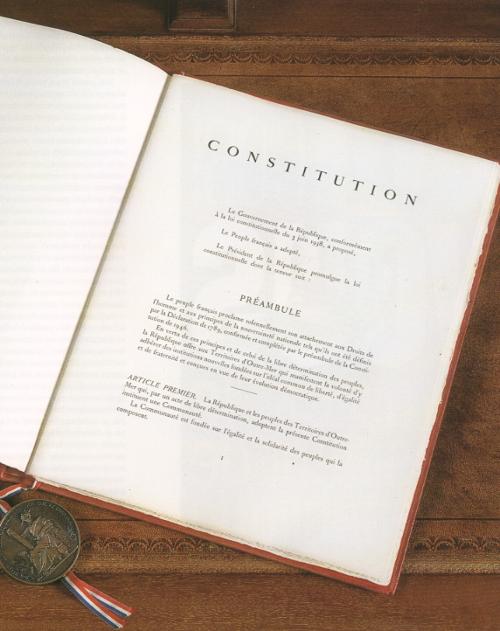 Text of the Constitution of FrancePhoto: Erasoft24 CC 1.0 Generic no changes made
Text of the Constitution of FrancePhoto: Erasoft24 CC 1.0 Generic no changes made
If desired, the president can even replace the prime minister, except when there is a so-called "cohabitation" in the government. This only occurs when the composition of the National Assembly is such that the president is forced to appoint a prime minister of a different political color from his own. After the elections of June 1, 1997, this situation arose when the neo-Gullist president Chirac ruled the country together with a cabinet and a Prime Minister Jospin, who were of leftist signature. The collaboration between Chirac and Jospin went quite smoothly for the first four years.
The government, headed by the prime minister, is proposed and appointed by the president. The government determines and implements the general policy of the country and is accountable to the National Assembly.
Legislative power is exercised by the parliament, which consists of two chambers. The National Assembly (Assemblée Nationale) has 577 members, 22 of whom are from overseas departments and territories. The Assembly is elected for five years through a district system. The senate is mainly elected by the members of the "conseils généraux", the departmental councils, and by the municipal councils.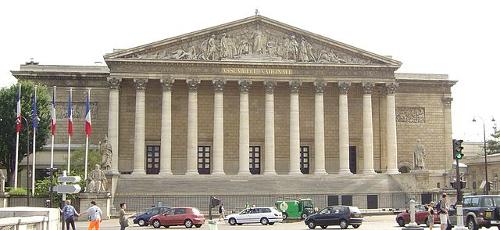 The Assemblée Nationale is located at Palais Bourbon in ParisPhoto: David.Monniaux CC 3.0 Unported no changes made
The Assemblée Nationale is located at Palais Bourbon in ParisPhoto: David.Monniaux CC 3.0 Unported no changes made
The senate has much less powers than the Assembly and has 321 members, 12 of whom are representatives of the French abroad and 13 for the overseas departments and territories. Senate members are elected for nine years and the senate is renewed for a third every three years. The president of the senate is the second highest office holder in the country after the president.
All French citizens of 18 years and older have the right to vote and to be elected to the Assembly one must be at least 23 years old and 35 years old for the Senate. Women have only had the right to vote since 1944.
Parliamentary and presidential elections take place in two rounds. If the candidate manages to obtain more than 50% of the vote in his constituency in the first round of the parliamentary elections, he is immediately elected. If he does not succeed, a second round follows in which a simple majority is sufficient. A condition for the parliamentary elections is that the candidate has obtained at least 12.5% of the votes in the first round.
In the presidential election, only two candidates who obtained the most votes in the first round can participate in the second round. For the current political situation see chapter history.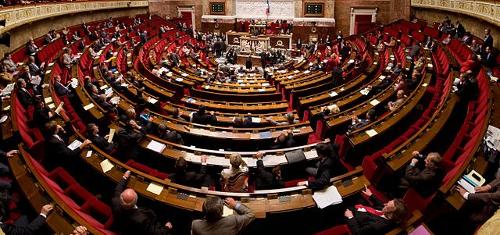 The hemicycle of the National AssemblyPhoto: Richard Ying et Tangui Morlier CC 3.0 Unported no changes made
The hemicycle of the National AssemblyPhoto: Richard Ying et Tangui Morlier CC 3.0 Unported no changes made
Administrative division
The French state has 22 regions, which are divided into 96 departments. The country also has: four overseas departments, the "Départements d'Outre-Mer" (DOM): French Guyana, Guadeloupe, Martinique and Réunion; three overseas territories, the "Territoires d'Outre-Mer" (TOM): French Polynesia, the Wallis and Futuna Islands and New Caledonia; the two overseas 'collectivités territoriales' Mayotte and St-Pierre-en-Miquelon and some areas on the South Pole, "Les Terres Australes et Antarctiques Françaises (TAAF). The prefet is in charge of each region and department and is the representative of the government and of each individual minister.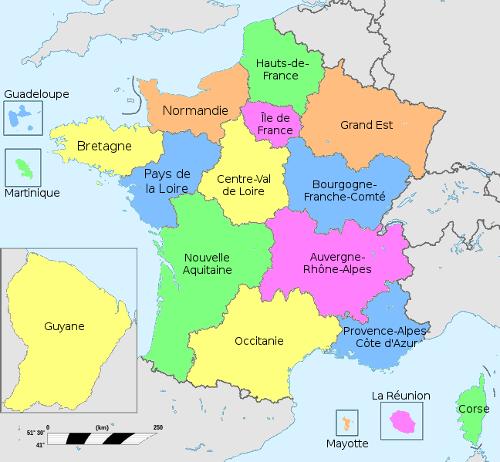 Regions of FrancePhoto: Mightymights CC 4.0 International no changes made
Regions of FrancePhoto: Mightymights CC 4.0 International no changes made
The departments are divided into arrondissements (325), headed by a sous prefet; the arrondissements are divided into cantons (3,714) and these in turn into 36,433 municipalities. Approx. 90% of the municipalities have less than 2000 inhabitants. The arrondissements and cantons have only administrative significance.
The Union of the Corsican People (Union du Peuple Corse) has been fighting for the island's independence for years and has many hundreds of bombings to its name. The region of Corsica has a separate status since 1981, a degree of self-government. The bombings then temporarily abated, but in 1982 more than 800 attacks were committed.
Education
Nursery and primary education
France has a long tradition of pre-primary education. It is therefore not surprising that the percentage of French children attending écoles maternelles is higher than in all other EC countries (excluding Belgium), and amounts to approximately 32% for two-year-olds and 100% for five-year-olds.
Pre-primary education is not compulsory and free in public schools (85% of all schools). The remaining 15% are schools for special or private (private) education that are subsidized by the state and / or region, and / or receive contributions from the families.
Education is compulsory for children from 6 to 16 years old. This obligation applies to primary education (école élémentaire) and the first cycle of secondary education (collège). Most pupils finish the four-year college at the age of 15 and then have to attend school in general technical or vocational education for at least one more year.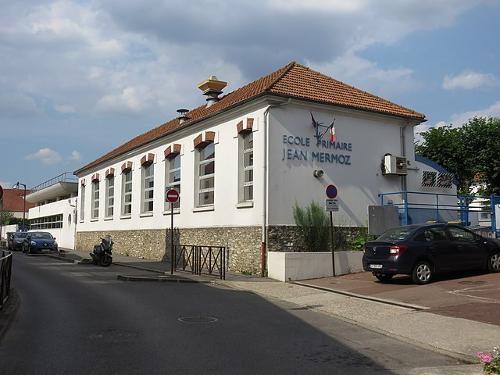 Primary school Roissy-en-FrancePhoto: Antony-22 CC 4.0 International no changes made
Primary school Roissy-en-FrancePhoto: Antony-22 CC 4.0 International no changes made
Primary education, organized and managed by the municipalities, lasts five years and is attended by children aged 6 to 11. The five grades comprise two cycles: the first cycle (cycle des apprentissages fondamentaux) starts in the highest section of the nursery school and further includes the first two years of primary school, which includes a preparatory and a first elementary year.
The second cycle (cycle des approfondissements) covers the last three years of primary school that precede the college. These three years comprise the second year of elementary training and the first two years of further training.
Secondary education
The first cycle of secondary education lasts four years and is intended for pupils aged 11 to 15 and is again divided into three cycles: the adaptation cycle, the intermediate cycle and the orientation cycle. The second cycle of secondary education comprises general, technical and vocational education, which is given in lycea (lycées).
General and technical secondary education prepares students in three years for the examination of the general baccalaureate or the technical baccalaureate.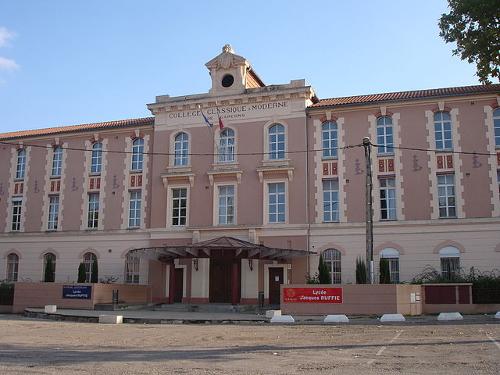 Secondary school Limoux FrancePhoto: Pinpin CC 3.0 Unported no changes made
Secondary school Limoux FrancePhoto: Pinpin CC 3.0 Unported no changes made
The vocational schools prepare the pupils in two years for the "certificat d'aptitude professionelle" (CAP) and the "brevet d'études professionelles" (BEP). The CAP is more specialized than the BEP and is issued for general professional skills, not in a specific subject but in one professional-commercial, administrative or social sector. After another two years, they can take an exam for the professional baccalaureate (baccalauréat professionnel). At the college, the study of a foreign language is compulsory from the sixth grade and from the 4th grade a second foreign or a regional language is learned. The study of a foreign language is compulsory in general and technical education.
At the end of the third year, pupils take a national exam with a view to obtaining the "diplôme national du brevet". The diploma is a general study certificate that does not determine the later choice of study.
General and / or technical education is concluded with a general or technical baccalaureate. Those who pass will gain access to higher education
Higher education
Higher education is provided in France by a wide variety of institutions. The organization and admission requirements differ according to the type of institution and the objective of the education provided.
Higher education institutions include:
-Universities that provide short courses and long courses. France has more than 70 universities. The Sorbonne in Paris is the oldest and dates back to the twelfth century.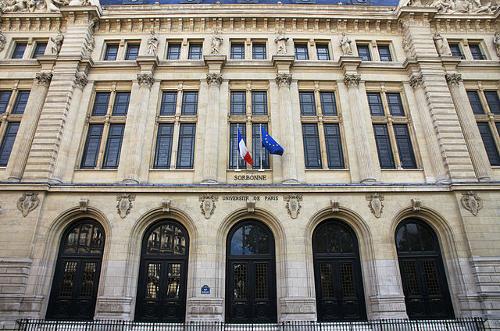 Entrance main building Sorbonne, ParisPhoto: NonOmnisMoriar CC 3.0 Unported no changes made
Entrance main building Sorbonne, ParisPhoto: NonOmnisMoriar CC 3.0 Unported no changes made
-Public and private schools and institutions supervised by a ministry and providing higher professional education. Again, short courses and longer of three years or more after the baccalaureate.
-The "lycées d'enseignement général et technologique" also offers post-baccalaureate courses that prepare for higher technical courses that prepare for the "brevet de technicien supérieur" in two years
-long three-year courses are given to the "grandes écoles" which are private or public. Most of the higher officials and engineers in France come from this type of educational institution.
National Anthem
The national anthem of France, the "Marseillaise", was written on April 25, 1792 by engineer officer Joseph Claude Rouget de Lisle and sung for the first time with the Baron of Dietrich, mayor of Strasbourg.
The song takes its name from a battalion of Marseillary volunteers who sang the song during their assault on the Tuileries Garden in Paris in August 1792. Due to its revolutionary origins, the song has been prohibited twice during the 19th century. Opinions about the Marseillaise are still divided.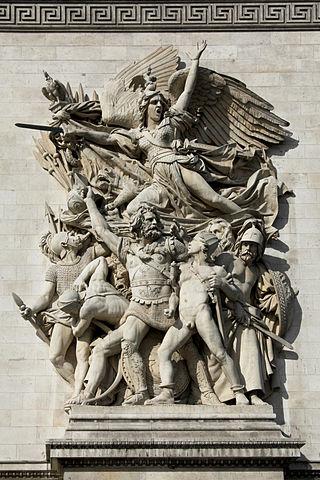 La Marseillaise, expressed by the sculptor François Rude on the Arc de Triomphe, ParisPhoto: Ana Paula Hirama CC 2.0 Generic no changes made
La Marseillaise, expressed by the sculptor François Rude on the Arc de Triomphe, ParisPhoto: Ana Paula Hirama CC 2.0 Generic no changes made
Economy
Picardy benefits from its perfect location between Germany, its main trading partner, the Ruhr and London. A considerable part of the industrial companies is owned by foreign companies. In total, approx. 150,000 people work in industry, the largest company being the Massy Ferguson et GIMA tractor factory. The main branches of industry, which are struggling due to globalisation, are:
- -food industry
- -chemistry - Oise valley
- -plastics sector
- -machine industry
- -automotive industry
- -aircraft construction - Albert
- -perfume and cosmetics industry - Beauvais, Lassigny, Compiègne
- -glass industry - Bresle valley
- -canning industry - Noyon
- -agricultural machinery - Beauvais
Only around 1.5% of the workforce is employed in the agricultural sector, which has a very strong influence on the landscape of Picardy, as almost three-quarters of the land is used for arable farming.
Picardy is France's largest producer of potato flour, salsify, sugar beet (one of the largest sugar factories in northern France is in Eppeville, about 70 km east of Amiens) and soya products. In addition, the fertile clay soil is mainly used to produce various types of potatoes (vitelotte á chair bleue, juliette des sables and de pompadour), barley, peas, green beans, spinach, wheat, flax, winter barley and chicory. The image of the department Aisne is largely determined by vast grain and rapeseed fields, and in the extreme south one benefits from the champagne production around the Marne.
In a number of areas, including Thiérache, Vimeu and Pays de Bray, there is a gradual move towards mixed farming, with the focus shifting from arable to livestock production. Famous regional cheeses are rollot, munster, tomme au foin and the most famous cheese of the region: the beer-washed and unpressed maroilles, produced with milk from black-pied Friesian cows. Red fruits such as strawberries, raspberries, currants and blueberries are grown especially around Noyon.
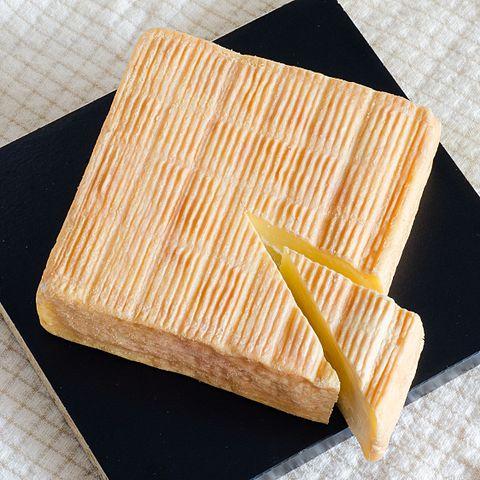 Maroilles, cheese from PicardyPhoto:BastienM CC 3.0 Unported no changes made
Maroilles, cheese from PicardyPhoto:BastienM CC 3.0 Unported no changes made
In 1665, the Manufacture Royale de Grandes Glaces was founded in Paris Faubourg Saint-Antoine, which in 1692 moved into an abandoned castle in the village of Saint Gobain in the Aisne department. This mirror glass manufacturing plant was the first to succeed in making glass of large dimensions. The factory in Saint-Gobain closed down on 31 December 1995, but Saint-Gobain is now a world leader in the field of living and working, with the glass division still only a small part of the group. The group, headquartered in Paris, is currently present in 67 countries and has 179,000 employees.
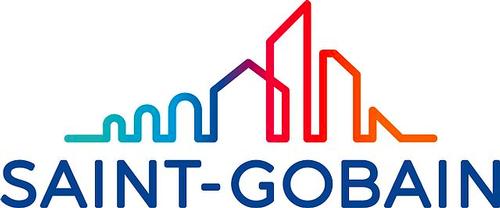 Logo of Saint-Gobain, located in Picardy early onPhoto: Naga213 CC 4.0 International no changes made
Logo of Saint-Gobain, located in Picardy early onPhoto: Naga213 CC 4.0 International no changes made
In the coastal town of Cayeux-sur-Mer, pebbles are extracted and processed for, among other things, house building and porcelain manufacturing. Silica is also extracted from it, and flint is made from pebbles with sufficient silica.
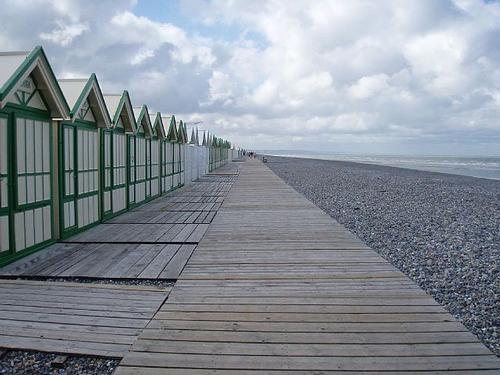 Pebble beach of Cayeux-sur-Mer, PicardyPhoto: Amanda Slater CC 2.0 Unported no changes made
Pebble beach of Cayeux-sur-Mer, PicardyPhoto: Amanda Slater CC 2.0 Unported no changes made
Picardy has very few major tourist attractions, which is why the focus is on strengthening and developing the so-called commemorative tourism, whereby the government and the private sector invest heavily in museums, war cemeteries, monuments and information centres about the First World War.
Many foreigners also visit the battlefields where their ancestors fought or died. Of the approximately 250,000 visitors to the Somme battlefields, more than half come from abroad.
Sources
BBC - Country Profiles
CIA - World Factbook
Heetvelt, Angela / Picardië : Nord-Pas-de-Calais
ANWB
Picardie : Somme-Oise-Aisne
Lannoo
Wikipedia
Copyright: Team The World of Info